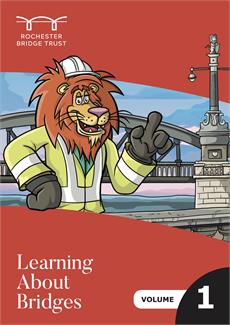
Rochester Bridge Trust
Stand F03
The Rochester Bridge Trust’s primary purpose is to provide and maintain (at Net Zero Carbon) its three bridges over the tidal River Medway. The charity also delivers education projects, scholarships, and charitable grants. All services are provided free of charge.
The stand is giving out free books to enable organisations to support or carry out engineering education.
Used by families, community groups and schools, ‘Learning About Bridges’ is two volumes of activities that introduce the principles of bridge building in a fun, engaging way – that’s easy for adults to implement with little fuss and minimal preparation.
Over its long history, the Trust has employed some of the country’s most noted engineers – Henry Yevele, John Rennie, Thomas Telford, Sir Joseph Bazalgette, Sir William Cubitt and Sir Basil Mott.
Rochester Bridge’s structures comprise the Old Bridge, which was built in 1856 and reconfigured as a bowstring-shaped truss in 1914 and the steel box-girder New Bridge, which was completed in 1970 along with the Service Bridge which runs between the two.
The charity, which was founded in 1399, is a unique survivor of the historic system of providing bridges. It is the only major medieval bridge trust that is independent of local government and still serving its original purpose – to provide crossings of the River Medway free of charge to the public.
The Trust remains committed to best practice and aims to be an exemplar practitioner in the field of bridge management by sharing learning with others and inspiring them to do likewise.
In 2023 – in acknowledgement of its achievements in carbon reduction – it was chosen as the winner of the Bridges Management category in the annual Bridges Awards.
To help ensure there will always be a bridge at Rochester, the Trust is committed to developing the next generation of civil engineers. It has a team of education officers who go into schools and community groups to offer bridge-building activities.
In addition, the Trust’s offers a ‘Let’s Build a Bridge’ challenge. This gives children aged nine and over the opportunity to make practical use of what they have learned in the classroom by building a bridge that’s large enough for them to walk across.
For more information about Rochester Bridge Trust, visit www.rbt.org.uk; to find out about its educational activities, go to www.rochesterbridgetrust.org.uk.
Products

Learning About Bridges vol 1
Lions Langdon and Leonie are pleased to present their education kit – Learning About Bridges! These easy to use books are designed to make it easy for anyone to inspire the next generation of civil engineers.
Learning About Bridges offers 12 chapters on the basics of bridge building, aimed at children aged 8-11 years (Key Stage 2). It is available to download as two complete books, or as a series of individual sessions with accompanying handouts.
Each session includes a range of activities that can be used individually or as part of a longer session for afterschool clubs and home-schooling as well as for classroom use.

Learning About Bridges vol 2
Learning About Bridges volume 1 introduces why we need bridges; loads and forces; materials; working with water; and beam, truss, arch, and suspension bridge types.
Learning About Bridges volume 2 encourages children to think like an engineer and consider the different roles available in civil engineering; further develops the concepts of loads and forces; introduces 'enemies' of bridges; the challenges tackled by bridge engineers; and cable-stayed, moving, and cantilever bridge types.